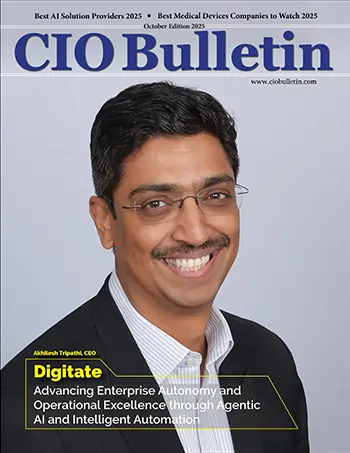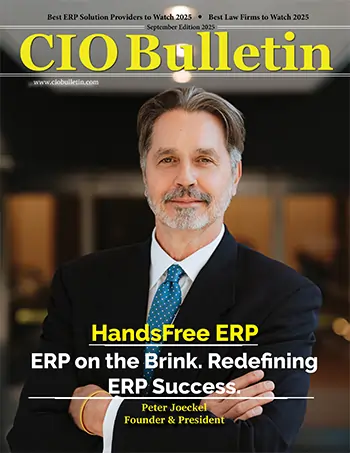50 Best Companies to Watch 2022
CIO Bulletin

Every successful organization has a robust and fully automated back-office supporting it. Not just for efficiencies but to foster innovation.
Enterprises have spent most of the last decade digitizing and transforming their front office. The reason? They felt that front office transformation is critical to improve the customer experience and scale rapidly.
For many in the business and tech world, the word digital still primarily conjures thoughts of sales, marketing, and customer experience initiatives that have dominated business mindshare and investments. It only makes sense, given the imperative for organizations to improve engagement with their key constituents, be they customers, citizens, patients, or business partners.
However, tech-savvy CFOs and CIOs realize that efforts to transform customer-facing systems and processes are limited without equally effective and integrated back-office operations. That digital interconnectedness is required to make critical data and intelligence residing in the core—related to pricing, product availability, logistics, quality, financials, and more—available to customer-centric operations.
Tying together enterprise functions and the core is a start, but it only scratches the surface of the digital transformation opportunity.
Simplifying AP solutions and automating back-office processes—xSuite’s reason for existence
xSuite Group was established in 1994. Back in the day, digitization was a brand-new topic for most companies. Back-office processes were paper-based and manual.
The founding idea of xSuite was to use the potential of digitization to simplify manual workflows. xSuite started by setting up digital archives and scanning solutions for their clients. However, the founders quickly realized that using software to automate workflows would be a real game-changer and provide significant benefits to businesses and their employees. So, they began developing their own software solutions. The first one was xSuite’s accounts payable (AP) solution for SAP.
Achieving the highest level of simplification and automation in operational business processes, such as vendor invoice processing, was and continues to be xSuite’s motivation. To accomplish this, the firm is constantly developing solutions, e.g., implementing AI technology, enabling a whole new level of automation.
The pressure on AP departments to become more efficient, flexible, scalable, and transparent is mounting. Hiring more people to cope with the vast amounts of paper no longer represents a solution. Implementing digitization and automation technology is key to enabling AP departments to position themselves for the future.
Another essential topic among xSuite’s target group is migrating from the classic SAP ERP to the new SAP S/4HANA product generation within the next few years. The firm accompanies its customers on this path and supports them with all questions regarding moving their financial processes to the cloud.
In Asia and Europe, the topic of e-invoicing (exchange of standardized, machine-readable invoice formats) is currently on the rise. This is due to the ongoing digitization but also legal requirements. xSuite is convinced there will be similar developments in the U.S. in the next few years.
To conclude, AP departments are in transition, and with xSuite, they have a technology and process expert and a long-term partner on their side.
Innovation and results— the driving force behind xSuite’s SAP dominance
“Innovation is a continuous process. We work closely together with our customers to get their feedback and input,” says Danny Schaarmann, CEO & President at xSuite North America Inc.
xSuite is interested in the details: How satisfied are clients with how its solutions perform in the daily work routine? What can be improved? Step by step, the firm implements customers’ feedback into their software.
When xSuite takes on a new digitization project for a client, it is always considered a process optimization project at the same time. This means that xSuite does not digitally replicate the customers’ manual processes but instead advises them on how they can simplify, improve, accelerate, and streamline their processes.
Of course, different organizations have different requirements and needs when it comes to automating their processes. The team at xSuite is aware that one size does not fit all. That is why they make the adaptability of xSuite’s solutions a priority.
At the same time, xSuite monitors the overall market development and actively looks out for upcoming technology trends. In xSuite’s opinion, the various technologies that come together under the umbrella term “artificial intelligence” are the central drivers of innovation in the Accounts Payable Invoice Automation (APIA) environment.
The firm’s strong focus on SAP sets them apart. Since around 90% of its customers use SAP as their ERP system, xSuite makes it a priority always to provide comprehensive support for SAP’s latest technologies and deployment models.
xSuite provides the best solution for APIA in SAP because they combine the following: they develop their own software,
have a deep understanding of accounting processes, and are true SAP experts. That is why 1,200 customers already rely on xSuite for precisely this topic.
Paving the road to the future of xSuite
Many companies have so far only digitized and automated parts of their processes. While individual work steps and tasks are already digital, others are still handled manually. xSuite’s goal is to ensure the holistic digitization and automation of business processes in the P2P sector.
In detail, this means:
Leading xSuite to simplify AP processes for its clients worldwide
Danny Schaarmann is the CEO and President of xSuite North America. He is a successful entrepreneur, a serial optimist, and a strategic go-to-market manager. Growing up as an athlete, Danny approaches his clients and colleagues with a team-driven, collaborative mentality.
Since 2016, Danny has been the CEO and President of Boston-based xSuite North America Inc. and strives to help SAP customers with their digital transition.







